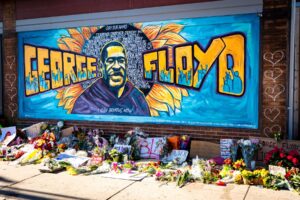Protecting your business or protecting your home? In many cases, work and home are now synonymous during the COVID-19 pandemic when so many organizations’ workers are working from home across America. Add in the additional pandemic of systemic racism and police brutality, protest marches against this pandemic, and the unfortunate rioting, looting, and property destruction that has occurred during civil unrest, and you have a perfect storm of new safety and security concerns for employees.
How do you support your employees when civil unrest comes to their towns? What do you do when civil disturbances, rioting, and looting spills into their neighborhoods and cities? What are things people should be aware of and sensitive to when managing their work from home lives during these unprecedented times?
 In the weeks that followed the police killing of George Floyd on a Minneapolis street corner, there were 14 days where a curfew was in effect in Minneapolis and Saint Paul prohibiting any travel after 8:00 pm and before 7:00 am. There were eight days in which all major freeways that connect Minneapolis, Saint Paul, and the suburbs were closed to all traffic beginning at 8:00 pm. Businesses closed early to coincide with the curfews and allow workers to get home before the curfew began.
In the weeks that followed the police killing of George Floyd on a Minneapolis street corner, there were 14 days where a curfew was in effect in Minneapolis and Saint Paul prohibiting any travel after 8:00 pm and before 7:00 am. There were eight days in which all major freeways that connect Minneapolis, Saint Paul, and the suburbs were closed to all traffic beginning at 8:00 pm. Businesses closed early to coincide with the curfews and allow workers to get home before the curfew began.
While the national media covered the most significant property destruction in Minneapolis and Saint Paul, what did not get any national media coverage is the fact that “pop-up” violence, rioting, looting, and destruction occurred throughout every neighborhood, including mine, in an attempt to distract and divert public safety resources and to inspire fear in residents.
Here are the things I learned through this experience and precautions people can take to protect their homes and be prepared:
- Hold a neighborhood meeting and share news updates or information and gather cell phone numbers for all neighbors. The adage of “get to know your neighbors,” is always applicable but it is especially important if your city or neighborhood is affected by civil unrest.
- Learn the police non-emergency phone number or program it into your phone contacts. We all know 911 but every city has a non-emergency phone number, too. It helps local law enforcement if you call when you observe something suspicious. In my neighborhood, there were dozens of cars driving around without license plates. Reporting the locations of non-licensed cars to the non-emergency line became a daily habit. It was later reported that the unlicensed cars were being driven by people participating in violence and looting.
- Download a police scanner app on your phone. Broadcastify is the world’s largest source of public safety live audio streams with a channel for every city in the United States and international cities. It can be helpful to know where police, fire, or EMS are being deployed, especially if routes in or out of the city are being closed.
- Take an evening walk around your neighborhood including a walk down the alleys. It may not be as scenic as a parkway or boulevard, but during the civil unrest in the Twin Cities, it became known that rioters were hiding gas cans, accelerants, and explosive devices in the bushes, behind garbage cans, and between garages so that they could come back later in the night and use them. If these materials are found, report them to local law enforcement.
- Move all garbage and recycling cans into your garage so that they are not available to be used to start fires.
- Clean up your yard and remove anything that can be used as a weapon to break into your home. Patio umbrellas, hammock stands, shovels, tools, and anything that can smash through a window should be stored in a garage or locked shed.
- Leave lights on in multiple rooms in the house and leave porchlights or yard lights on all night long.
- Withdraw cash from your bank’s ATM in sufficient quantity to meet several weeks’ worth of cash needs. My local bank branch was heavily damaged in the riots; it did not restore a working ATM machine until four months after the civil unrest had ended in June.
- Plan your grocery shopping to allow for trips to occur during the daytime. Take time off work, if necessary, as you may need to travel outside your neighborhood to find an open grocery store and return home before a city-imposed curfew. If we had not already been stocking up on groceries due to COVID-19 and minimizing trips, not having an open grocery, drug, or Target store in our city would have been a bigger inconvenience.
- If you think you may have to leave your neighborhood due to civil unrest, establish an evacuation plan with your family. Pack a “go bag” you can carry as you run out the door. Make sure prescription medications, important papers (vital records, banking, property deeds, vehicle registrations, insurance paperwork, estate planning documents, etc.) and packed and available when you leave. If possible, ensure these documents are stored on a secured jump drive.
- Ensure your car has a full tank of gas and allow enough time for refilling in the event you need to leave your neighborhood to find an open gas station. There were no open gas stations within the city limits of Minneapolis or Saint Paul for over two weeks. People often had to drive to second and third-ring suburbs or Wisconsin border towns (20-40 miles) to find an open gas station that had fuel.
- Learn the best route out of your neighborhood or city without using major freeways.
- Create a group chat text message that includes all family members that you want to evacuate with or that you would want to notify in the event something happened to you or your home. Establish a meet-up place outside of the neighborhood where all family members can check-in or can stay for several days, if necessary.
- Review FEMA’s Ready.gov website for more details about evacuation plans and emergency alerts. While not specifically geared towards civil unrest, it has many applicable checklists and guidelines that are relevant for employee safety and security during any emergency situations.

Dawn is a principal consultant with over 25 years of experience in project management and operations for government consulting contracts.



